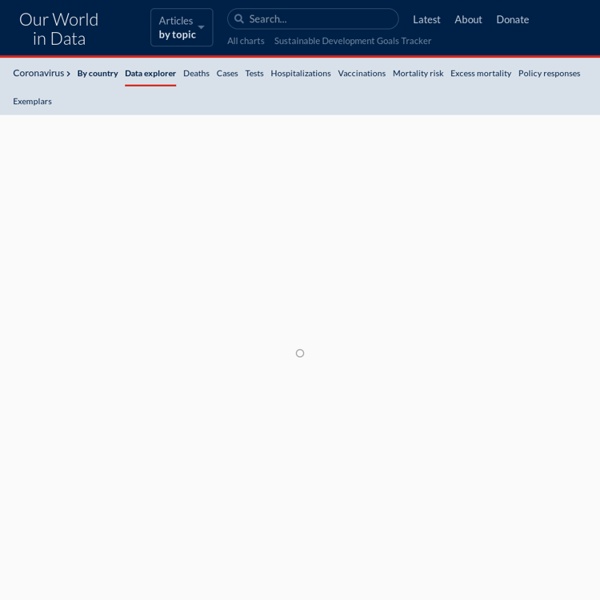



https://ourworldindata.org/coronavirus-data-explorer
Related: Math and Data of SARS-COV-2 • Maths • chiffres et courbesThird Surge Brings Record-Breaking Case Rates Across the Nation, This Week in COVID-19 Data, Oct 29 This week’s update is brought to you by Artis Curiskis, Alice Goldfarb, Erin Kissane, Júlia Ledur, Alexis Madrigal, Jessica Malaty Rivera, Charlotte Minsky, Kara Oehler, Joanna Pearlstein, Sara Simon, Peter Walker, and Nadia Zonis. The United States set a new record for reported cases this week, breaking 500,000 for the first time in the pandemic as the third surge continued to build across nearly every state in the country. Twenty-five states have set a new record for cases in the last two weeks, including 17 states with record highs since last Wednesday.
COVID Cases since June by state partisanship The numbers are the total confirmed normalized* cases per million for each state since June. A '10,000' means 1% of the state's population has tested positive of COVID since June 1. June 1 was chosen as it was around that time that countries worldwide that had been sucker-punched months before had the opportunity to apply proven preventative measures. It also provided an opportunity to contrast the resulting data with states' political affiliations, using the Cook Partisan Voting Index.
The Relationship Between Temperature and Fall Cases – A Case of Three Regions – Smart Remarks Fall temps are negatively correlated with COVID-19 cases. As it gets colder, people spend more time indoors, where the virus is more easily spread. Since Fall began COVID-19 has been surging again, but still varies dramatically by region. The Midwest is the hardest hit region.
Is US COVID-19 Case Total Highest Globally Due to 'Great Testing'? As governments fight the COVID-19 pandemic, Snopes is fighting an “infodemic” of rumors and misinformation, and you can help. Read our coronavirus fact checks. Submit any questionable rumors and “advice” you encounter. Become a Founding Member to help us hire more fact-checkers.
Coronavirus Updates (COVID-19) Deaths & Cases per 1M Population Subscribe Sign In | Subscribe Ad-Free RCP Coronavirus Tracker Coronavirus (COVID-19) Global Deaths Coronavirus (COVID-19) U.S. The COVID Tracking Project Our public data API provides access to all of our data at a national and state level. We provide data in both JSON and CSV format. You can also download CSV data directly. All dates and times are in US eastern time (ET). Each state has its own set of caveats, which we have documented on our data page. Our data is provided under our project-wide data license. The Path to Zero: Key Metrics For COVID Suppression – Pandemics Explained Harvard Global Health Institute, Harvard's Edmond J. Safra Center for Ethics, Rockefeller Foundation, CovidActNow, Covid-Local, CIDRAP and many others join forces, launch new COVID Risk Level map and COVID suppression guidance for policy makers and the public Cambridge, July 1, 2020 -- Uncertainty is the currency of pandemics. As evidence on the new coronavirus, how it spreads and who falls ill from it emerges slowly, policy makers and the public have to base their decisions on the best information available. Experts help interpret the evidence, but they may differ on details that can be confusing for non-experts -- and filtering out what matters from a rising sea of misinformation has become a daunting task. To help cut through the noise and sometimes conflicting advice, a network of research, policy and public health experts convened by Harvard’s Global Health Institute and Edmond J.
The Covid-19 Tracker As the virus that causes Covid-19 spreads worldwide, this dashboard offers a snapshot of the crisis right now. Click on a country name to get a more detailed geographic breakdown at the state, province, or county level. Please note that because of limited testing capacity in some areas, the actual number of cases is believed to be higher.
IDSS COVID-19 Collaboration (Isolat) - IDSS Isolat: a data-driven approach to addressing the COVID-19 pandemic IDSS COVID-19 Collaboration (Isolat) is a volunteer collaboration organized by IDSS to provide systematic and rigorous analyses of data associated with the Covid-19 pandemic in order to inform policy makers. Email idss-isolat@mit.edu to collaborate with the group, or with any questions you may have. While the specific questions are evolving as more data is collected, there are three broad areas that this group is addressing: creating a data structure of heterogeneous data sets (e.g., spread of virus, mobility, interventions)performing prediction of various critical time-dependent variablesunderstanding the effects of intervention and policies on the spread of this virus. We recognize that much of the data is noisy and that testing is evolving slowly, hence the quantification of uncertainty of our results is key to providing actionable outcomes.
Time Series Analysis Using ARIMA Model In R Time series data are data points collected over a period of time as a sequence of time gap. Time series data analysis means analyzing the available data to find out the pattern or trend in the data to predict some future values which will, in turn, help more effective and optimize business decisions. Methods for time series analysis COVID-19 resources View the COVID-19 projections This page was last updated at 2 p.m. Pacific, May 12, 2020. To view the changes to the model, please visit our estimation updates page.